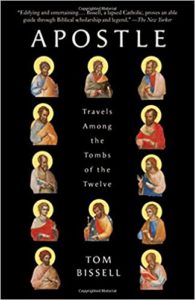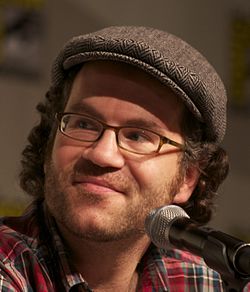
Apostle: Travels Among the Tombs of the Twelve
By Tom Bissell (Uzbekistan 1996)
Vintage Paperback
517 pages
February, 2017
$11.52 (paperback), $26.76 (hardback), $11.99 (Kindle)
Reviewed by Denis Nolan (Ethiopia 1964-66)
•
When I first saw what this book was about, I became very interested. The front of the book says that is “Travels among the tombs of the Twelve”, and I thought I would learn a great deal about the legends and knowledge of where the apostles are buried. This is of interest to me, for I have been doing a fair amount of research into the early Christian religion and have found a number of discrepancies about what people in the gospels did after the death of Jesus and where they finished their lives .
The book begins with a chapter on Judas Iscariot. At least that is what the title is. However, it is more about the discrepancies among the gospels concerning Judas, and the number of explanations about the writers in the early church. It doesn’t go into a description about the tomb of Judas because there is no such thing. Two of the gospels tell about the death of Judas, but they are in disagreement and there is no one place that is attributable to that. From that point on, many of the chapters are more concerned with the travels of the author rather than an explanation of traditions and knowledge about the actual apostles and the arguments about where they died and are buried.

Tom Bissell
The chapter on Peter is probably the best, with an explanation of the many traditional stories about where Peter traveled, how he died, and where he is buried. The chapter on Thomas, who supposedly went to India to preach, is more concerned with the diarrhea that the author suffered while in India. He never really gets into the beliefs in India, about the travels of Thomas and what happened to him, and he never fully explains the beliefs of possibly the oldest established Church in Christian history .
The Final Chapter on James, the son of Zebedee, is only 4 pages long and has really nothing about James. It is about the 25 days the author spent walking through Spain on a pilgrimage. After reading that chapter, I went back and read the author’s introduction. I realize now that I should have done that at the beginning, because he does more explaining in that section than in most of the rest of the book. There are good number of explanations about some of the Apostles and their travels, but too often these are so complex and mixed in with the author’s travels that I did not come away with a feeling of satisfaction. There is not a pattern to the chapters, so by the end of the book I was unsure of what I was supposed to have gotten out of it.
Hopefully, others will find it far more fascinating.
•
Denis Nolan (Ethiopia 1964-66) was raised in pre-Vatican II Catholicism, went to St. Ignatius high school and then Notre Dame where he earned a degree in engineering. For four years he worked in the space industry and then joined the Peace Corps. After his service, he returned to college and earned teaching credential in history and has taught for 35 years in Northern California. Denis had also been doing research into Christian development since the time of Christ to the present and thus was particularly interested in reading this book.


The book sounds interesting and Denis’s review is most insightful. Knowing when to focus on what one learns on a journey and knowing when and how to insert one’s own story and feelings is always a challenge. A fine line I tried to walk in “Different Latitudes, My Life in the Peace Corps and Beyond” and a line I still struggle to walk in my writing to this day.
Thank you, Denis, for a fine review that will help readers to discern which goal to pursue in the decision to read the book or not—travel writing, religious history or both.
We were just in India, mostly in Chennai, this last December. The Santhome Cathedral Basilica Church was on our list because it is one of only three places where the bones of an apostle are reported to be buried (Rome and Santiago are the other two). We went there on Christmas Eve, so the church was probably a bit more festive than usual. But in all, it was unremarkable, with its devotional opportunities set up at a distance from devotees (unlike the lively devotional practices that animated all the Hindu temples we visited). In the South, devotion remains central to Hindu life, and it shows. It doesn’t surprise me that the author found describing the tomb of Doubting Thomas a bit of a challenge. (And what a pity that Bissell got laid low by diarrhea in South India, which arguably has one of the most intricate, delicious cuisines in the universe. Those who love the food know that I am not exaggerating.)
Here’s Amazon’s paragraph on the book:
“The story of Twelve Apostles is the story of early Christianity: its competing versions of Jesus’s ministry, its countless schisms, and its ultimate evolution from an obscure Jewish sect to the global faith we know today in all its forms and permutations. In his quest to understand the underpinnings of the world’s largest religion, Tom Bissell embarks on a years-long pilgrimage to the apostles’ supposed tombs, traveling from Jerusalem and Rome to Turkey, Greece, Spain, France, India, and Kyrgyzstan. Along the way, Bissell uncovers the mysterious and often paradoxical lives of these twelve men and how their identities have taken shape over the course of two millennia.”
Reading the above paragraph and seeing the truly admirable cover of the book might lead one to become disappointed, if one thought he/she would actually learn more about the Apostles. From what Denis wrote, I’d probably be sorely let down by what is reported from India and how little really appears there about Thomas.
Amazon’s take on the book — by whoever wrote the squib — unfortunately seems to betray the norms of truth-in-advertising.